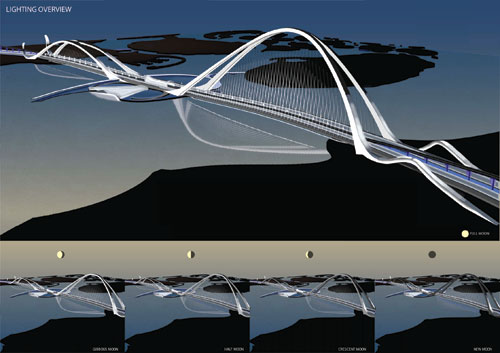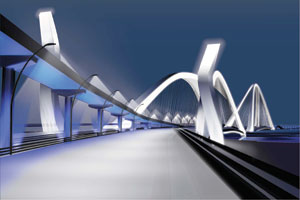Model Behavior: Anticipating Great Design
Moonlighting
When designing Dubai's Sheikh Rashid bin Saeed Crossing, the architects at FXFOWLE looked to cultural references rather than climatic conditions, drawing inspiration from Middle Eastern sources such as Arabic calligraphy to develop the bridge's rhythmic arches. Six car lanes will traverse the bridge in each direction over Dubai Creek, along with two light-rail tracks and pedestrian walkways. When completed, likely in 2012, the bridge will be comprised of two separate spans linked by an artificial island, the west of which measures one-mile-long and 673-feet high-the longest and tallest spanning arch bridge in the world. To light the enormous structure, FXFOWLE turned to AWA Lighting Designers. They too took inspiration from local traditions. "The crescent moon is very important in Islamic culture. We decided to tie in the lighting of the bridge with the lunar calendar and create a giant moon dial," says Abhay Wadhwa, principal at AWA.
 |
The lighting design for the Sheikh Rashid bin Saeed Crossing in Dubai, UAE, will allow the bridge's nighttime lit appearance to subtly respond to the five distinct phases of the moon during the monthly lunar cycle: full moon, three-quarter moon (gibbous), half moon, crescent moon, and new moon. AWA Lighting Designers used the lighting analysis software program AGi32 to simulate the moon phases over the bridge. Image courtesy AWA Lighting Designers |
Â
Simply put, as the moon gets brighter, so does the bridge. To achieve that basic concept, however, AWA developed a complex mathematical algorithm to calculate the quantities of light reflected from the surface of the two arches. The fact that they were dealing not with straight lines or regular arches confounded the issue even further since they had to modulate the lighting across the length and height of the bridge.
Another challenge was to establish a system for controlling the fluctuations of light levels throughout the predictable 291â„2-day lunar cycle. Since maintenance-friendly, energy-efficient light sources are not dimmable, gradations of light would have to be achieved by way of a complex switching system involving multiple layers of light.
In mirroring the lunar cycle, AWA developed a separate lighting scene for each phase of the moon's illumination, including the full, gibbous, half, crescent, and new moons. "To get a certain amount of uniformity, we had to design the lighting for all five settings," Wadhwa explains. "Each setting has a different zone of light on it, so when we do the calculations and simulations, we have to do it for all five zones." On the brightest night (full moon), all five zones are switched on. The front and inside elevations-the most prominent feature of the lighting design-are lit by fixtures located on 61â„2-foot-long outriggers.
|
The new moon phase is not represented by complete darkness, but instead emits a subtle glow suggestive of the dim light that is reflected by the moon during a total lunar eclipse. For two days, observers will see this glow, which results from gentle reflection of the light used to illuminate the bridge cables. The lighting of the arches returns with the appearance of the crescent moon, the most significant phase of the moon for followers of Islam. After this point, the arches' light alternately accumulates and dissipates in sync with the rest of the moon's phases. Reflections of the illuminated arch in the water beneath the bridge "complete the circle" of the full moon's profile.
"Painting a pretty picture is one thing," Wadhwa says. "Being able to deliver it is really what the simulation software is about." Starting with extensive Excel spreadsheets that measured items such as the distance a beam of light travels, AWA then used AGi32-a lighting-analysis program for lighting calculations and renderings of electric lighting and daylighting systems-to confirm their projected algorithmic calculations. "After we entered our calculations into the program, we found that we had accurately specified 95 percent of the lighting. We then had to go back and tweak the other 5 percent, much of it through trial and error."
All of these projects represent designs in progress. The architect's job is to integrate the information provided by these simulation programs into their design. "That's when the input from these types of analytical programs is truly successful," says Buro Happold's Herman. "Ideally, you'd never know that changes to the design had ever happened. Everything about the finished structure would simply look like it was always meant to be there."









